#answering what I had asked
Note
In response to your tags on this post

I can’t remember which post I saw first, but I reblogged one from 2012/2013 and realized I should just scroll back to to see what other old Jonsa posts were on their blog and then I’d click over to the people they were reblogging from. A lot of fans had deactivated or deleted all their Jonsa posts, but there is a surprising amount of stuff from that time! Someone said the tumblr Jonsa tag only goes back to 2011. I did not verify that tho 😂
you’re a gift to us @esther-dot genuinely don’t know what we would do without you <3
#but here’s to finding posts older than 2011 hehe 🤭#esther-dot#<333#asks#answering what I had asked#jonsa#asoiaf#asoiaf fam
38 notes
·
View notes
Text
Today I would like to shout out that one random Twitter person who made up that JD Vance bragged about fucking a couch.
Imagine making a random shitpost and less than two months later your joke is being used by a major party nominee for Vice President on live television at his introduction rally, earning him thunderous applause.
That poster must be having quite the experience.
#politics#us politics#tim walz#for the record I am super fucking psyched for Walz#I think he did a great job#And I think Harris made the right call#harris 2024#Harris Walz 2024#jd vance#Vance is never beating the couchfucker allegations#The problem with your party making actual reality much less relevant in political discourse is that it can also bite *you* in the ass#Functionally it doesn't matter that JD Vance never bragged about fucking a couch#Because it got repeated so many times that now it's indelibly linked to him#If someone asked random people what they think when they see Vance I'd bet money one of the top 3 answers would be “had sex with a couch”#As it should be#Because it wouldn't have happened if his vibes weren't so atrocious that everyone immediately believed it
2K notes
·
View notes
Note
begging... pleading... for a bigger version of that pikachu gif (if possible), i am so utterly enchanted with it its unreal (i have that exact plush in my house!!!)

#hope this is what u mean#he's carmelas :) though im pretty sure i also had the exact same one ?!#also if anyone wants him transparent im sorry but my transparency machine broke and i dont know why#ask#potion of answers your question#Anonymous
5K notes
·
View notes
Text

gem, what happened to your eye?
(wanted to upload this panel separately, original is from this comic)
#my art#geminitay#secret life#icr exactly when but there was this moment earlier in the series#where someone asked gem what was up with her eye (because her skin had one green eye and one yellow eye)#and her response was smth like 'i'm yellow now!'#and i was like wait that's SO GOOD#bc there's an established tradition of ccs changing their skins to match the color of their current life#so the person (scott i think?) was obviously asking about the eye that was still *green*#but her answering that way implies she took the question to mean 'why did your eye color change'#because /the other one isn't her eye/
3K notes
·
View notes
Note
Request: Jed and octavius dancing on/playing the piano like in that scene from the movie Big.
(Your art is amazing)
Like this? 🎹🎵🎶
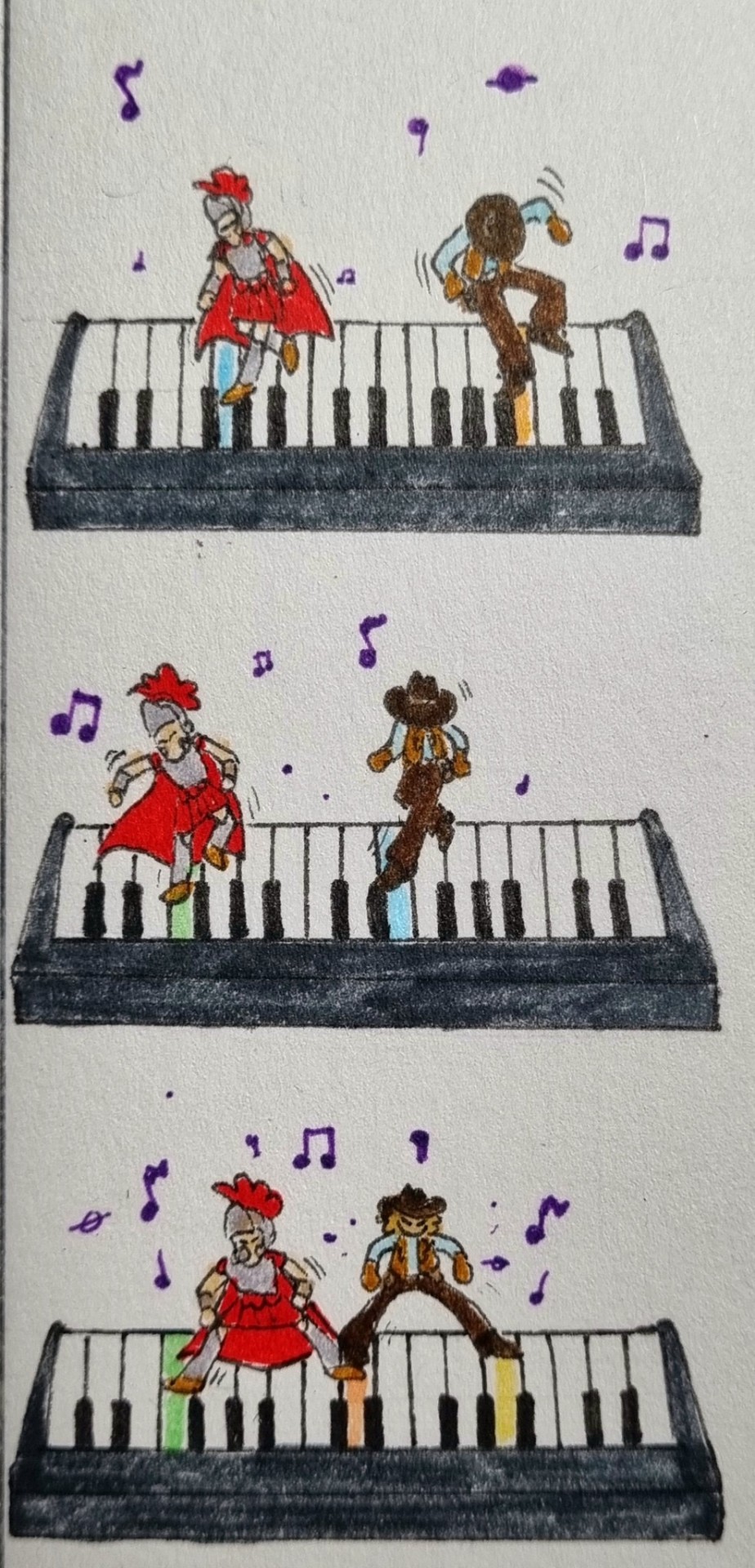
Maybe they can have an iPad too
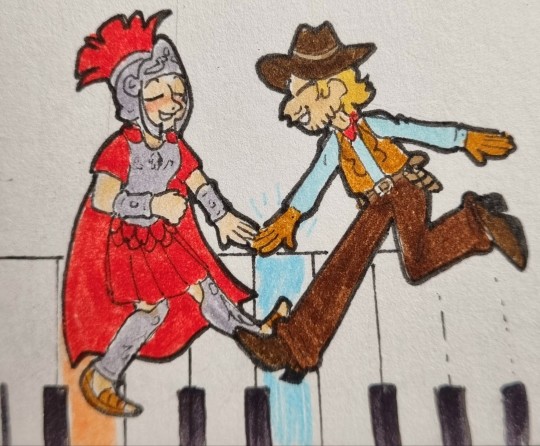

#strategically placing the colors of the piano keys#so they start in each other's colors and end up on their own. do you see my vision#i haven't even heard of that movie before so naturally I had to watch it. for science#first it was Lightning McQueen now a piano (3 times I might add). what's next. what's my next 'impossible to draw traditionally' challenge?#anyway#ask#anonymous#answered#night at the museum#natm#natm octavius#natm jedediah#jedediah smith#gaius octavius#jedediah and octavius#jedtavius#fanart#art#traditional art#Also thank you for liking my art#I hope these little drawings are satisfactory#inaccurate notes because I haven't played piano in years (I really shouldn't have stopped learning. maybe I can start violin instead..)#big (1988)
634 notes
·
View notes
Text
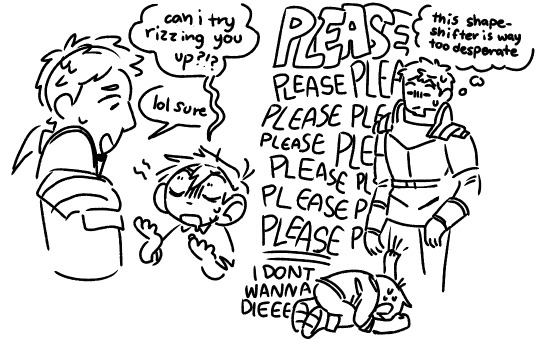

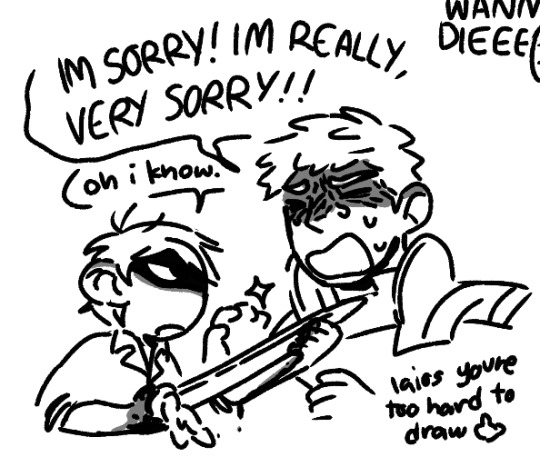
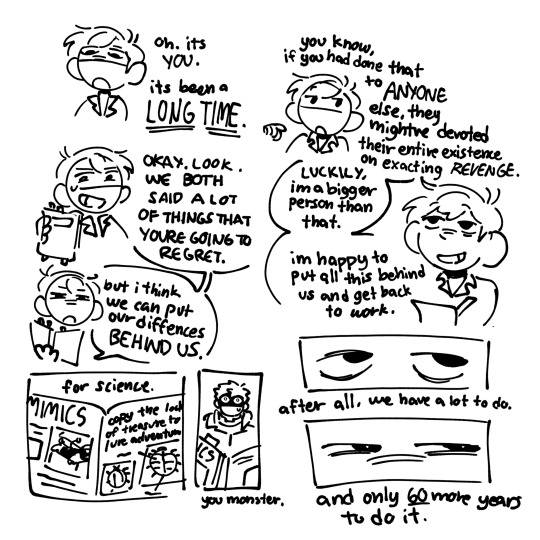


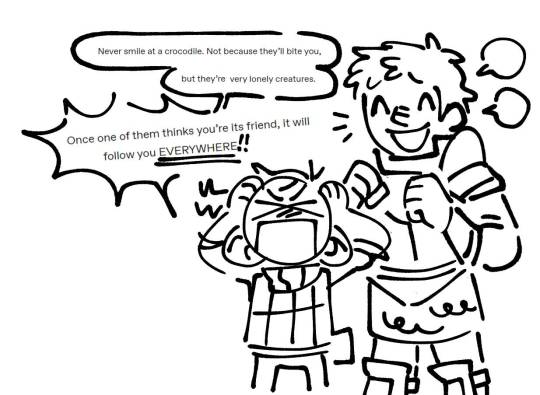
more misc au art... (the last two are unrelated but shh)
GAAAHHHH i promise ive got actual stuff cooking im just scared to post it/motivation to finish art Hard :"D clutching my head... always forever 24/7 thinking about them...
#i actually may or may not finish the second one because its meant to be a finished comic but i gave up early JSNDJSHDS#also yes the fourth one is glados quotes THE LINES FIT HIM SCARILY WELL#i wouldve drawn more of those if i had the motivation (i listened to an hour of glados voicelines just because i was brainrotting on him)#uhh what else do i have to say... OH UH ILL ANSWER ASKS..... SOMETIME!! SORRY THAT ITS BEEN SO LONG IVE BEEN BUSY#well not anymore now that schools over but STILL#[ tragedy au ]#man i GOTTA share some Actual Cool Stuff sometime...#chilaios#should i main tag...? eh sure#dungeon meshi#chilchuck#chilchuck tims#laios touden#laios#its always so embarrassing BAHSHSHA#id talk more because GOSH do i have a lot to talk about but its late#dungeon meshi spoilers#<- I FORGOT TO ADD IT#tragedy comedy
398 notes
·
View notes
Note
for the art thing... lawlight 👉👈 ? they look so cute in your style no pressure though 🙇
my pleasure - thank you so much ☺️
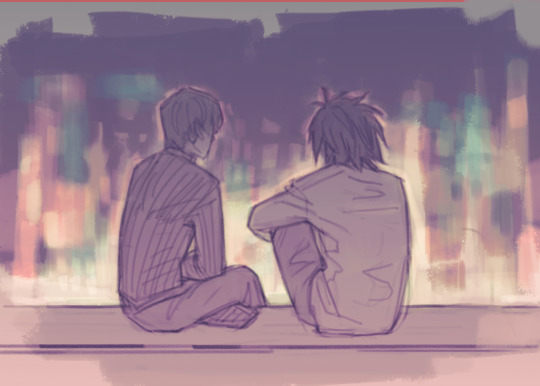
#answered asks#requests#lawlight#light yagami#l lawliet#death note#thank you so much!#sorry if this is not what you had in mind#not really sure where i was going with this 😅
438 notes
·
View notes
Note
Hello hellsitegenetics! I gotta tell you, you are my favourite blog in this digital jungle and your work really brings a smile to my face (: it's very cool, keep it up! Every time I see the phrase "string identified" i imagine a robot voice saying that (as a lead up to an output) which makes it very funny when it appears in a reblog - just wanted to tell you that. Anyways, I actually have a real question for you: What's your favourite "string identified" so far?
Greetings from a biology nerd!
String identified:
tgtc! gtta t , a at g t gta g a a g a t ac (: t' c, t ! t t a "tg t" ag a t c ag tat (a a a t a tt) c a t t aa a g - t at t t tat. Aa, acta a a a t : at' at "tg t" a?
Gtg a g !
Closest match: Neoneuromus ignobilis isolate Gutianshan chromosome 5
Common name: Dobsonfly

(image source)
#tumblr genetics#genetics#asks#requests#sent to me#tigoteus#bugs#flies#insects#dobsonfly#biology#congratulations on being the latest appearance of the dobsonfly!#i hope when you see my addition followed by lots of random letters you hear printer noises. because thats what i hear personally#anyway. i get the question ''whats your favorite x'' often but thats a very hard question to answer#definitely ONE of my faves is the time my buddy absolutelydedinside#(you may know them as the dottore selfshipper i keep BLASTing)#got malaria as one of their results#another favorite is the time FNAF connection terminated speech got homo sapiens#we've had lots of fun ones hehe
447 notes
·
View notes
Text

something awful (Not the forum)
@spitinsideme i'm sorry
#i had this idea and needed to get it out of my head#i was losing it#she's absolutely shocked#still processing what happened#lmao#jesus christ#absolutely disgusting!!!!!!#anyway#currently not having much time for art but#i can still make low quality stuff#also please answer me something#demon ragatha needs blood right??#or am i mistaken#if so does period blood count#i swear i'm just asking for curiosity#no dark intentions or anything#period blood#cw blood#tw blood#cw suggestive#suggestive#shitpost#my art#tadc pomni#tadc ragatha#tadc au#tadc fanart#the amazing digital circus#buttonblossom#pomni x ragatha
403 notes
·
View notes
Text
Art Progress Timeline

It's hard to see this stuff as it's happening, and it's easy to think you're not making progress, so it's good to do these every once in a while. 'finished dww' is both a personal milestone and an excuse to draw them so small, so tiny, but also the point where i didn't have to split focus between two creative disciplines so could focus on the art. been boning up on the fundamentals this year. i've no formal art education (though i did always want it, life had other plans), so i'm thrilled to see i'm getting to where i want to go. hoping 2025 is a good art year for me too
#fallout 4#fo4#nick valentine#rochedotpng#highlight of the year was for sure the death shroud pick#lowlight was realistic paint studio ceasing to work. why. why did it do that. i had to buy a whole other program#here's to more That Old Man#in the spirit of being rebuffed and needing to teach myself out of necessity: if you ever have process questions#or want tips or brushes or what have you#feel free to ask even if i've answered before#it's art: you can't do it so wrong somebody dies#so if you've ever wanted to take it up go for it!
359 notes
·
View notes
Text
Someone needs to say it: The "Heaven is actually bad" plot line that Hazbin is based around is useless when you spend more then 2 minutes thinking about Vivzie's Hell and her characters.
Besides it being much too early for this idea, the revelation that Heaven or at least the beings running it aren't good people has little to no impact when the people who are being harmed by this are all horrible people. Stay with me here. None of these people are people who were unfairly brought into hell and we are never ever introduced to someone who was either. Why should we care that Heaven is "evil" and blocking redemption when all the sinners in hell we see are the worst of the worst who would have never gotten in even if it was fair.
For the "Heaven is bad" plot line to actually work, you need people who were just one sin away from Heaven, who would've gotten into Heaven if circumstance hadn't forced them down a path that stole it from them. You need characters who aren't comedic villains but land in the middle of morally grey. Those who deserved to be in Heaven but because Heaven refused to consider their circumstances, they were tossed to burn with people much worse than them. Those are the people who should be your main cast cause those are the people who would actually be impacted by Heaven being bad/ Heaven lying.
Angel dust, for all his trauma, was still part of the mafia and likely had killed people before (showing to almost take joy in it). Husk became an overlord and gambled souls, so he had to have had blood on his hands before hell. Alastor is a serial killer, and the list goes on and on. Sure, these characters are (somewhat) interesting, but they don't make for good characters to have when the key plot line is that Heaven is a scam. Even if that fact is true, none of them were ever going to get there in the first place and this is something we also se in every single background sinner shown in Hell too. They were never close to getting there, so why would they or we care that Heaven is bad when all sinners are shown to be horrific people who are at best in the dark grey area of morality.
If you look at it from the "angel's are unfairly killing sinners" route, it still doesn't work. If the angels are killing them, what makes it different then the sinner on sinner violence that hell is full off? Why is them dying by angels this bad thing when they are just as likely if not 10x times more likely to get knifed in the back by other sinners in hell the other 364 days, especially when everyone here apparently is just as horrible as the next person. You cannot condemn the angels for killing demons and then make a joke of out sinners killing each other and never show sinners who doesn't want to kill people. Life either matters or it doesn't and when the main cast doesn't even show a care for life (outside of Charlie's who's entire flaw is her naivety), why should the audience.
On top of that, Vivzie's whole overpopulation aspect and the Heaven plot line would connect better if she actually had people like those I mentioned above, people who stole to survive but got tossed out cause stealing is technically wrong, people who killed another to protect someone else but were still sent to hell because even though they saved that person's life that person wasn't supposed to be saved, people who passively engaged in sins but never really did anything harmful under them. This would add into how Hell is so overpopulated and highlight why its so important that Heaven is evil/ why Charlie's plan isn't just a naive pathetic fever dream.
In the end, Vivzie should have never made Heaven the central plot of this show nor tried to assign this blatant good vs evil to that conflict. Neither her characters nor her writing choices are able to respond to this conflict in a way that will end or even tell the story in a satisfactory manner.
#anti hazbin hotel#hazbin hotel critical#vivziepop critical#spindlehorse critical#spindlehorse criticism#also I am not just talking out my ass for this#I had/have this same problem in one of my original works#where I had to make the relationship between Heaven and God and cambion a lot more complex then just oh this side bad this side good#and thats what you have to do as a fucking writer is ask the hard question and be ready to scrap characters and ideas to answer them#When you deal with human characters nothing is black vs white and the minute you claim it is#you have failed
953 notes
·
View notes
Text

definitely the most *mumblemumble* story of all time, I reckon.
#sophie.txt#dank mha meems#mha critical#gonna try answering some asks this weekend now that I've more or less accepted that mha's ending is the pits#work doesn't really give me any free time these days so i've been trying to spend what time i do have off on stuff that's more rewarding 😔#i've never had a series go from like a 8.5/10 to like a 3/10 if-i'm-being-generous in so few chapters though lmfao
288 notes
·
View notes
Text

💘
#this is the painting equivalent of my pencil sketches#I tried to go fast & just be intuitive with the colors#I think it took me 45 min?#im getting used to adding the color🫶 & im excited to keep going!!!#esp since I’ve started making it look more watercolory & I’m getting better at knowing what colors I want to use#bc tbh I love pencil bc I just need to think of light & shadows but with color there is the whole thought process behind#what do I even choose😳 (I just stick with greens bc Slytherin & also my favorite color🙏)#anyways kind of a scandalous sketch😳😳 but I love it…💘#hope you all had an amazing day🥹🫶#tomorrow I’ll do some sketches and start answering ask mountain🥰🥰🥰🥰🥰🥰🥰🥰#hogwarts legacy#hogwarts legacy fanart#hphl#hogwarts legacy mc#hogwarts legacy oc#eloise babbit#sebastian sallow#sebastian sallow fanart#sebastian sallow x mc
170 notes
·
View notes
Text
My coworkers think I'm crazy because I said I thought all the earthquakes I lived through in California (low magnitude, nothing serious) were cool and that I want to see a tornado (from a safe distance).
Assuming no serious injuries or major property damage:
#I've felt multiple small earthquakes and it's a life goal to see a tornado with my eyeballs#I'm sure if i had experienced a major one of these it would be a different answer#but that's not what i asked broskis
324 notes
·
View notes
Text



#sam reid#interview with the vampire#iwtvedit#iwtv#*#im hmm ehh that this question was even asked#it puts actors in a difficult position because what are they supposed to say#sam reid was very nice with his answer VERY GENEROUS but they should not bring these questions to actors#it wont change anything#one peek over at twitter/x and some people are already being nasty about this#ANYWAY#this is how i do fandom too sam reid!!#one peek at fandom during s1 and i had to just ignore it#i want to enjoy the show
208 notes
·
View notes
Note
hey you might've been asked this before sorry if so, but have you read or do you have any thoughts on A short history of Trans Misogyny?
I have read it! I have a few thoughts.
I think it's a strong and important work that compiles historical archives into sharp analyses of how "trans misogyny" (using Jules Gill-Peterson's spacing) is not a recent phenomenon but a globalized structure with centuries of history. I also think it's flawed, for reasons I'll get into after a quick summary for those who haven't had the chance to read it yet.
JGP divides the book into three main chapters, the first on the notion of "trans panic". There, she traces how variants of this anxiety with the trans-feminized subject have presented—to deadly effect, for the subject—in such different settings as early colonial India, the colonization of the Americas, the racialized interactions between US soldiers stationed in the Philippines and the local trans women living there, and of course the contemporary United States itself. In every case she analyzes this "panic" as the reaction of the capitalist colonial enterprise to the conceptual threat that the trans-feminized subject poses; we are a destabilizing entity, a gender glitch that undermines the rigid guarantees of the patriarchal order maintaining capitalism. Punishment follows.
The second chapter is my favourite, and considers the relationship between transfeminine life and sex work. I posted a concluding excerpt but the thrust of the chapter is this: that the relegation of so many trans women and trans-feminized people to sex work, while accompanied by the derogation and degradation that is associated with sex work, is not itself the mere result of that degradation inflicted upon the subject. In other words, it is not out of pure helplessness and abjection that so many trans-feminized people are involved in sex work. Rather, sex work is a deliberate and calculated choice made by many trans-feminized people in increasingly service-based economies that present limited, often peripheralized, feminized, and/or reproductive, options for paid labour. Paired with a pretty bit of critical confabulation about the histories of Black trans-feminized people travelling the US in the 19th century, I think this made for great reading.
In her third chapter, JGP narrativizes the 20th century relationship between the "gay" and "trans" movements in north america—scare quoted precisely because the two went hand-in-hand for much of their history. She emphasizes this connection, not merely an embedding of one community within another but the tangled mutualism of experiences and subjectivities that co-constituted one another, though not without tension. Then came the liberal capture of the gay rights movement around the 70s, which brought about the famous clashes between the radicalisms of Silvia Rivera and Marsha P Johnson (neither of whom, JGP notes, ever described themselves as trans women) and the institutions of gay liberalism that desired subsumption into the folds of capital. This is a "remember your history" type of chapter, and well-put.
I think JGP is correct to insist, in her introduction, on the globalizing-in-a-destructive-sense effects of the colonial export of trans womanhood. It is, after all, an identity conceived only mid-century to make sense of the medicalized trans subject; and "gender identity" itself (as JGP describes in Histories of the Transgender Child) is a psychomedical concept conceived to rein in the epistemic instability of trans existence. This is critical to keep in mind! But I also think JGP makes a few mistakes, and one of them has to do with this point.
In her first chapter, under the discussion of trans misogyny in colonial India, JGP of course uses the example of the hijra. Unfortunately, she commits two fundamental errors in her use: she mythologizes, however ambiguously, the "ascetic" lives of hijra prior to the arrival of British colonialism; and she says "it's important to say that hijras were not then—and are not today—transgender". In the first place, the reference to the "ascetism" of hijra life prior to the violence of colonialism is evocative of "third-gender" idealizations of primeval gender subjectivities. To put the problem simply: it's well and good to describe the "ritual" roles of gendered subjects people might try to construe contemporarily as "trans women", the priestesses and oracles and divinities of yore. But it is best not to do so too loftily. Being assigned to a particular form of ritualistic reproductive labour because of one's failure to be a man and inability to perform the primary reproductive labour of womanhood-proper is the very marker of the trans-feminized subject. "Ascetism" here obviates the reality that it wasn't all peachy before (I recommend reading Romancing the Transgender Native on this one). Meanwhile, in the after, it is just wrong that hijra are universally not transgender. Many organize specifically under the banners of transfeminism. It's a shame that JGP insists on keeping the trans-feminized life of hijra so firmly demarcated from what she herself acknowledges is globalized transness.
My second big complaint with the book is JGP's slip into a trap I have complained about many times: the equivocation of transfemininity with femininity (do you see why I'm not fond of being described as "transfem"?). She diagnoses the root of transmisogyny as a reaction to the femininity of trans women and other trans-feminized subjects. In this respect she explicitly subscribes to a form of mujerísima, and of the trans-feminized subject as "the most feminine" and (equivalent, as far as she's concerned) "the most woman". Moreover, she locates transfeminist liberation in a singular embrace of mujerísima as descriptive of trans-feminized subjectivity. As I've discussed previously, I think this is a misdiagnosis. Feminization is, of course, something that is done to people; it is certainly the case that the trans-feminized subject is in this way feminized for perceived gender-failure. This subject may simultaneously embrace feminized ways of being for all sorts of reasons. In both cases I think the feminization follows from, rather than precedes, the trans misogyny and trans-feminization, and there is a fair bit of masculinization as de-gendering at play too, to say nothing of the deliberate embrace of masculinity by "trans-feminized" subjects. Masculinity and femininity are already technologies of gender normalization—they are applied against gender deviation and adapted to by the gender deviant. The deviation happens first, in the failure to adhere to the expectations of gender assignment, and I don't think these expectations can be summarized by either masculinity or femininity alone. I think JGP is effectively describing the experience of many trans-feminized people, but I do not think what she presents can be the universalized locus of trans liberation she seems to want it to be.
Now for a pettier complaint that I've made before, but one that I think surfaces JGP's academic context. In her introduction she says:
In truth, everyone is implicated in and shaped by trans misogyny. There is no one who is purely affected by it to the point of living in a state of total victimization, just as there is no one who lives entirely exempt from its machinations. There is no perfect language to be discovered, or invented, to solve the problem of trans misogyny by labeling its proper perpetrator and victim.
Agreed that "there is no perfect language to be discovered"! But JGP is clearly critical of TMA/TME language here. Strange, then, that less than ten pages later she says this:
this book adds the phrase trans-feminized to describe what happens to groups subjected to trans misogyny though they did not, or still do not, wish to be known as transgender women.
So JGP believes it is coherent to talk about "groups subjected to trans misogyny", which she thinks consists of the union of trans women and what she called "trans-feminized" groups. If this is to be coherent, there must be groups not subjected to trans misogny. So we've come around to transmisogyny-subjected and not transmisogyny-subjected. Look: you cannot effectively theorize about transmisogyny without recognizing that its logic paints a particular target, and you will need to come up with a concise way of making this distinction. But JGP dismissing TMA/TME with skepticism about "perfect language" and immediately coining new language (basically TMS/not TMS) to solve the problem she un-solved by rejecting TMA/TME... it smells of a sloppy attempt to make a rhetorical point rather than theoretical rigour. It's frustrating.
I have other minor gripes, like her artificial separation of "trans women" from "nonbinary people" (cf. countless posts on here lamenting the narrow forms of existence granted TMA people if we want recognition as-such!) or her suggestion that "a politics of overcoming the gender binary" is mutually exclusive from rather than necessarily involved with struggles around "prison abolition, police violence, and sex work". Little things that give me the sense of theoretical tunnel-vision. But I don't think all this compromises the book's strengths as a work of broad historical analysis. I would simply not take every one of its claims as authoritative. Definitely give it a read if you have the chance, especially for the second and third chapters.
#ask answer#jules gill-peterson#(i haven't been asked this before ty for asking <3 🐐)#note that this was mostly off the cuff except what i had taken pictures of bc i left the book in toronto for my mom to read
380 notes
·
View notes